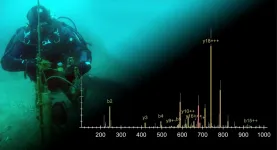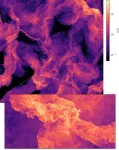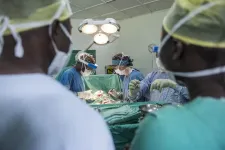"This is the first time we have observed a typical massive star-forming galaxy in the distant Universe about to 'die' because of a massive cold gas ejection," says Annagrazia Puglisi, lead researcher on the new study, from the Durham University, UK, and the Saclay Nuclear Research Centre (CEA-Saclay), France. The galaxy, ID2299, is distant enough that its light takes some 9 billion years to reach us; we see it when the Universe was just 4.5 billion years old.
The gas ejection is happening at a rate equivalent to 10 000 Suns per year, and is removing an astonishing 46% of the total cold gas from ID2299. Because the galaxy is also forming stars very rapidly, hundreds of times faster than our Milky Way, the remaining gas will be quickly consumed, shutting down ID2299 in just a few tens of million years.
The event responsible for the spectacular gas loss, the team believes, is a collision between two galaxies, which eventually merged to form ID2299. The elusive clue that pointed the scientists towards this scenario was the association of the ejected gas with a "tidal tail". Tidal tails are elongated streams of stars and gas extending into interstellar space that result when two galaxies merge, and they are usually too faint to see in distant galaxies. However, the team managed to observe the relatively bright feature just as it was launching into space, and were able to identify it as a tidal tail.
Most astronomers believe that winds caused by star formation and the activity of black holes at the centres of massive galaxies are responsible for launching star-forming material into space, thus ending galaxies' ability to make new stars. However, the new study published today in Nature Astronomy suggests that galactic mergers can also be responsible for ejecting star-forming fuel into space.
"Our study suggests that gas ejections can be produced by mergers and that winds and tidal tails can appear very similar," says study co-author Emanuele Daddi of CEA-Saclay. Because of this, some of the teams that previously identified winds from distant galaxies could in fact have been observing tidal tails ejecting gas from them. "This might lead us to revise our understanding of how galaxies 'die'," Daddi adds.
Puglisi agrees about the significance of the team's finding, saying: "I was thrilled to discover such an exceptional galaxy! I was eager to learn more about this weird object because I was convinced that there was some important lesson to be learned about how distant galaxies evolve."
This surprising discovery was made by chance, while the team were inspecting a survey of galaxies made with ALMA (https://www.eso.org/public/teles-instr/alma/) , designed to study the properties of cold gas in more than 100 far-away galaxies. ID2299 had been observed by ALMA for only a few minutes, but the powerful observatory, located in northern Chile, allowed the team to collect enough data to detect the galaxy and its ejection tail.
"ALMA has shed new light on the mechanisms that can halt the formation of stars in distant galaxies. Witnessing such a massive disruption event adds an important piece to the complex puzzle of galaxy evolution," says Chiara Circosta, a researcher at the University College London, UK, who also contributed to the research.
In the future, the team could use ALMA to make higher-resolution and deeper observations of this galaxy, enabling them to better understand the dynamics of the ejected gas. Observations with the future ESO's Extremely Large Telescope could allow the team to explore the connections between the stars and gas in ID2299, shedding new light on how galaxies evolve.
INFORMATION:
More information
This research was presented in the paper "A titanic interstellar medium ejection from a massive starburst galaxy at z=1.4" to appear in Nature Astronomy (doi: 10.1038/s41550-020-01268-x).
The team is composed of A. Puglisi (Centre for Extragalactic Astronomy, Durham University, UK and CEA, IRFU, DAp, AIM, Université Paris-Saclay, Université Paris Diderot, Sorbonne Paris Cité, CNRS, France [CEA]), E. Daddi (CEA), M. Brusa (Dipartimento di Fisica e Astronomia, Università di Bologna, Italy and INAF-Osservatorio Astronomico di Bologna, Italy), F. Bournaud (CEA), J. Fensch (Univ. Lyon, ENS de Lyon, Univ. Lyon 1, CNRS, Centre de Recherche Astrophysique de Lyon, France), D. Liu (Max Planck Institute for Astronomy, Germany), I. Delvecchio (CEA), A. Calabrò (INAF-Osservatorio Astronomico di Roma, Italy), C. Circosta (Department of Physics & Astronomy, University College London, UK), F. Valentino (Cosmic Dawn Center at the Niels Bohr Institute, University of Copenhagen and DTU-Space, Technical University of Denmark, Denmark), M. Perna (Centro de Astrobiología (CAB, CSIC-INTA), Departamento de Astrofísica, Spain and INAF-Osservatorio Astrofisico di Arcetri, Italy), S. Jin (Instituto de Astrofísica de Canarias and Universidad de La Laguna, Dpto. Astrofísica, Spain), A. Enia (Dipartimento di Fisica e Astronomia, Università di Padova, Italy [Padova]), C. Mancini (Padova) and G. Rodighiero (Padova and INAF-Osservatorio Astronomico di Padova, Italy).
ESO is the foremost intergovernmental astronomy organisation in Europe and the world's most productive ground-based astronomical observatory by far. It has 16 Member States: Austria, Belgium, the Czech Republic, Denmark, France, Finland, Germany, Ireland, Italy, the Netherlands, Poland, Portugal, Spain, Sweden, Switzerland and the United Kingdom, along with the host state of Chile and with Australia as a Strategic Partner. ESO carries out an ambitious programme focused on the design, construction and operation of powerful ground-based observing facilities enabling astronomers to make important scientific discoveries. ESO also plays a leading role in promoting and organising cooperation in astronomical research. ESO operates three unique world-class observing sites in Chile: La Silla, Paranal and Chajnantor. At Paranal, ESO operates the Very Large Telescope and its world-leading Very Large Telescope Interferometer as well as two survey telescopes, VISTA working in the infrared and the visible-light VLT Survey Telescope. Also at Paranal ESO will host and operate the Cherenkov Telescope Array South, the world's largest and most sensitive gamma-ray observatory. ESO is also a major partner in two facilities on Chajnantor, APEX and ALMA, the largest astronomical project in existence. And on Cerro Armazones, close to Paranal, ESO is building the 39-metre Extremely Large Telescope, the ELT, which will become "the world's biggest eye on the sky".
The Atacama Large Millimeter/submillimeter Array (ALMA), an international astronomy facility, is a partnership of ESO, the U.S. National Science Foundation (NSF) and the National Institutes of Natural Sciences (NINS) of Japan in cooperation with the Republic of Chile. ALMA is funded by ESO on behalf of its Member States, by NSF in cooperation with the National Research Council of Canada (NRC) and the Ministry of Science and Technology (MOST) and by NINS in cooperation with the Academia Sinica (AS) in Taiwan and the Korea Astronomy and Space Science Institute (KASI). ALMA construction and operations are led by ESO on behalf of its Member States; by the National Radio Astronomy Observatory (NRAO), managed by Associated Universities, Inc. (AUI), on behalf of North America; and by the National Astronomical Observatory of Japan (NAOJ) on behalf of East Asia. The Joint ALMA Observatory (JAO) provides the unified leadership and management of the construction, commissioning and operation of ALMA.
Links
Research paper - https://www.eso.org/public/archives/releases/sciencepapers/eso2101/eso2101a.pdf
Photos of ALMA - https://www.eso.org/public/images/archive/category/alma/
For scientists: got a story? Pitch your research - http://eso.org/sci/publications/announcements/sciann17277.html
Contacts
Annagrazia Puglisi
Centre for Extragalactic Astronomy, Durham University
Durham, United Kingdom
Email: annagrazia.puglisi@durham.ac.uk
Emanuele Daddi
Commissariat à l'énergie atomique et aux énergies alternatives (CEA)
Saclay, France
Email: edaddi@cea.fr
Chiara Circosta
Department of Physics & Astronomy, University College London
London, UK
Email: c.circosta@ucl.ac.uk
Bárbara Ferreira
ESO Public Information Officer
Garching bei München, Germany
Tel: +49 89 3200 6670
Cell: +49 151 241 664 00
Email: pio@eso.org



